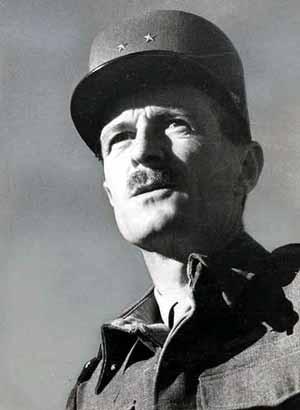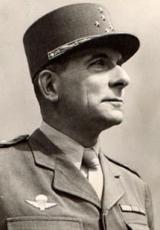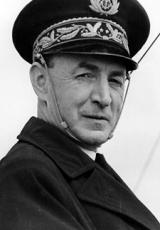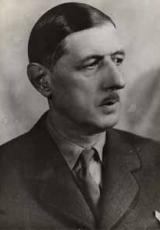Philippe Leclerc

On the 22nd November 1902 in Belloy (Picardy) Philippe de Hauteclocque, the fifth of six children was born to the count Adrien and Marie-Thérèse Van der Cruisse de Waziers. Originally from Artois, his family, from a long line of nobility dating back to the XIIth century, participated in the crusades, served at Fontenoy, at Wagram and held office as town councillors. During his childhood spent in a rural and traditional environment, he learned exceptional hardiness and a passion for hunting, an ardent patriotism, and a Christian faith anchored in Roman Catholicism, reinforced through his education by the Jesuit fathers of Providence in Amiens. He pursued an army career at Saint-Cyrien in the "Metz-Strasbourg" division, and after a first posting in Germany, opted for a posting to Morocco, first as an instructor at the School for native officers of Dar El-Beïda, then at the head of a goum during the peacemaking operations amongst dissident tribes.
He then became a school instructor at the special military school of Saint-Cyr before being admitted to the War school in 1938, an opportunity that opened up prospects of a fine career. Meanwhile, in 1925, he married Marie-Thérèse de Gargan, related to Wendel, with whom he would go on to have six children. The captain of Hauteclocque was promoted to general of the 4th infantry division who were surrounded by the enemy in June 1940 in Lille. He was captured, before escaping to rejoin the front, where he was then posted to the 2nd armoured division. Wounded and hospitalised on army orders, he then escaped the advancing enemy and fled to Paris by bicycle. It was here that he decided to join general de Gaulle in London by travelling through Spain, however not before seeing his wife who approved his decision and agreed to take care of their children. The captain of Hauteclocque became Leclerc. In London, he learned of the general de Gaulle's strategy of political combat: to keep France in the war as a sovereign nation. The leader of the campaign to free France then assigned general Leclerc with a political mission supported by Cameroon on the 26th of August; a further mission, on the 12th November also rallied the support of Gabon, which Vichy wanted to make a base for reconquering the unoccupied part of the French African territories. With the civilian zone secured and the Italians in Libya under severe pressure, the priority became to show that the French were continuing to fight the war. Colonel Leclerc was promoted to military commander of Chad, operating base for these manoeuvres.
On the 1st March 1941, after careful preparations, Leclerc took control of Koufra, an Italian oasis in southwest Libya, the first exclusively French victory. Leclerc then swore "only to lay down our arms once our flag, our noble flag, is fluttering above Strasbourg cathedral". News of the battle travelled all the way back to occupied France. A Franco-English agreement made plans for a military campaign led from Chad to facilitate the English offensive against the Afrikakorps on the Libyan coast from Egypt. With his Chadian soldiers, Leclerc conquered the Fezzan in 1942 and on the 26th January 1943 joined general Montgomery, commandant of the 8th British regiment, whom he convinced to join the campaign in Tunisia. The "L Force", as Leclerc's units were henceforth to become known, distinguished itself during the battle of Ksar Rhilane on the 10th March where, with the help of the Royal Air Force, it provoked heavy losses to a German armoured unit. After being exiled for several months in Libya, whilst general de Gaulle was overthrowing general Giraud, the 2nd Free French division (the former "Force L") officially became the 2nd armoured Division on the 24th August 1943. The 2nd armoured division in Témara (Morocco) owed its unity to its leader, despite the fact that it was a mix of men and women from widely varying political and military backgrounds.
At the end of 1943, de Gaulle entrusted Leclerc with a further political mission: to liberate the capital. The 2nd armoured division was therefore transferred to England at the end of April 1944 to hone their skills. Integrated into the general Patton's IIP Army, it landed at Utah-Beach on the 1st August and received a baptism of fire at Mortain. It then went on to distinguish itself once more during the battle of Normandy. In mid-August, general Leclerc waited impatiently for the order to liberate Paris and to establish the provisional government's authority. Leclerc's determination, as well as the missions sent by the colonel Roi-Tanguy, commandant of the FFF of Paris and general de Gaulle's insistence all convinced Eisenhower not to bypass the capital. The 2nd armoured division made contact with the FFF, forcing the enemy to surrender and preparing general de Gaulle's arrival. Thanks to the determination of its leader, the 2nd armoured division liberated Paris swiftly and with very few casualties. Leclerc, liberator of Paris but also its saviour, since the war was not yet over and his unit had some tough battles ahead of it yet at Bourget to drive back the German counter-offensive. The 2nd armoured division continued its progress: on the 13th of September at Dom-paire, the coordination of firepower and manoeuvres with an air attack broke down an enemy offensive. Baccarat was liberated on the 30th, Badonviller and Cirey-sur-Vezouze on the 17th and 18th November, the Vosges was reached by the 22nd. A feat of daring, the result of meticulous preparations, led to the liberation of Strasbourg. Leclerc had steadfastly held to his oath made at Koufra. Attached to the lre army (led by Lattre), the 2nd armoured division participated in reducing the Colmar pocket. The Alsace campaign was also gruelling and cost many lives. Leclerc requested a transfer to the American operation. After a period of leave at Châteauroux, during the course of which a part of the Division, on Langlade's orders, participated in reducing the Royan pocket (15-17 April 1945), Leclerc finally convinced the Allies to join the final combat in Germany, the high point being the storming of Berchtesgaden when the French flag was finally hoisted above Hitler's villa on the 5th of May.
Superior commander of troops in the far East under the orders of admiral Thierry d'Argenlieu, high-commissioner and commandant-in-chief, Leclerc left for Indochina with a dual mission: to re-establish French sovereignty and to represent France in forcing the Japanese to surrender. His time in Ceylan spent under admiral Mountbatten convinced him that diplomatic and political action should be integral to his manoeuvres. More than many of his contemporaries, he realised the importance of the national movement in Vietnam. He re-established order in Cochinchine and in Annam at the end of 1945 - beginning of 1946 and, returning to Tonkin, simultaneously prepared the military and diplomatic action (Sainteny - Hô Chi Minh agreements of the 6 March 1946). His ideas about men on the ground were opposed to the principles of those who, such as de Gaulle or d'Argenlieu, Moutet or Bidault, risked undermining French Union by their measures more often taken by forced than by agreement. He subsequently requested another transfer. In July 1946, he was appointed inspector of ground troops in North Africa, a posting that was interrupted by a mission in Indochina on the request of the president of the President of the Council Léon Blum in December 1946. Leclerc did not dismiss the idea of an agreement with the nationalist leaders but he refused to be drawn into any spiralling military offensives. He declined the offer to succeed d'Argenlieu, fearing political isolation and the risk of not receiving the resources he requested.
He then returned to his duties as Inspector, which had been extended to include the army, navy and air force. Faced with the political difficulties in North Africa, he was in favour of a more moderate evolution of the situation over time, less extreme in its ends than for Indochina. However, on the 28th November 1947, his plane crashed near the border of Algeria and Morocco near to Colomb-Béchar. He died along with seven officers from his squadron and four flight engineers. The leader's public funeral was held on the 8th December, for which de Gaulle wrote: "Never was there any mediocrity about him, neither in his thoughts nor in his speech nor his acts" He was posthumously awarded the title of Marshal of France in 1952. His courage, tenacity, and influence on his soldiers and his sudden death, have all contributed to making him a legendary character and ensuring his place in the history books.




